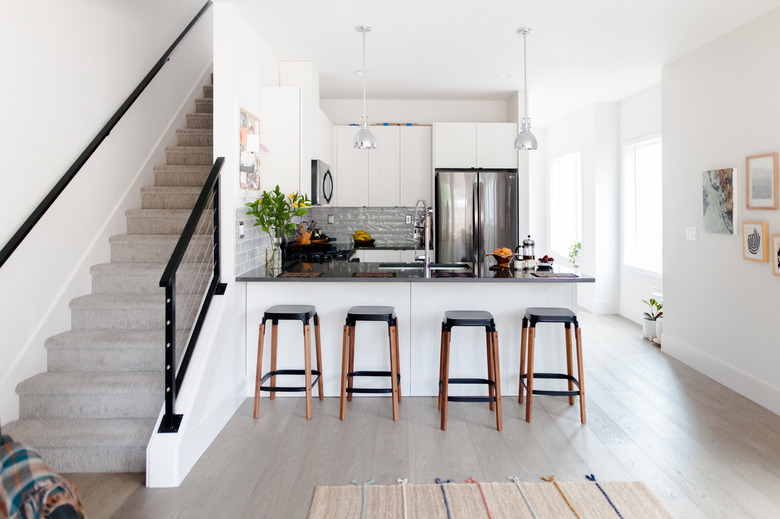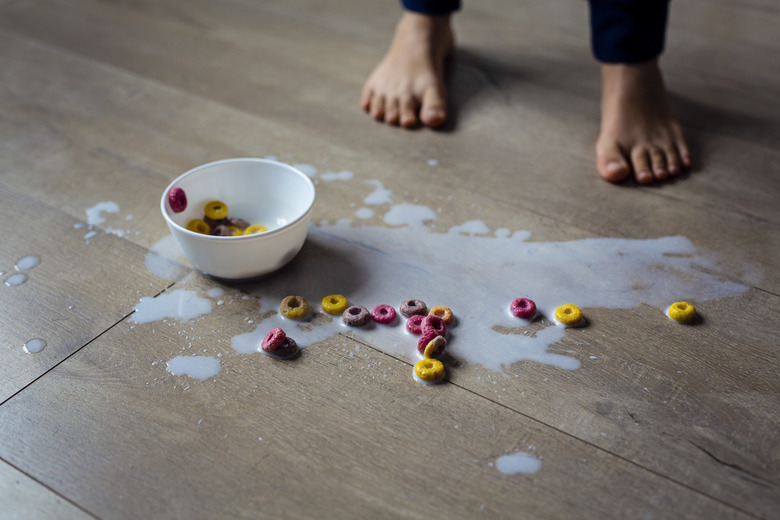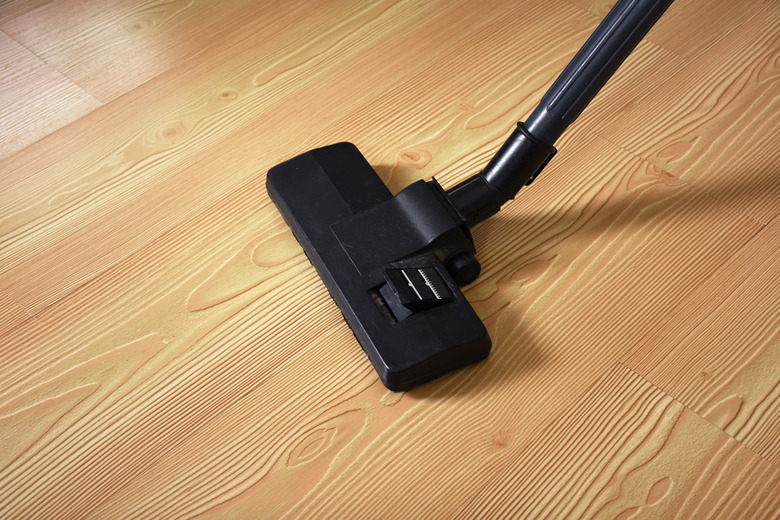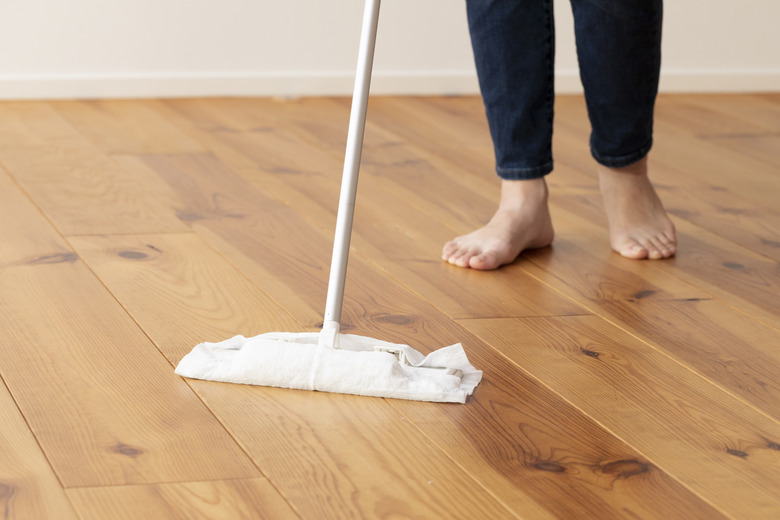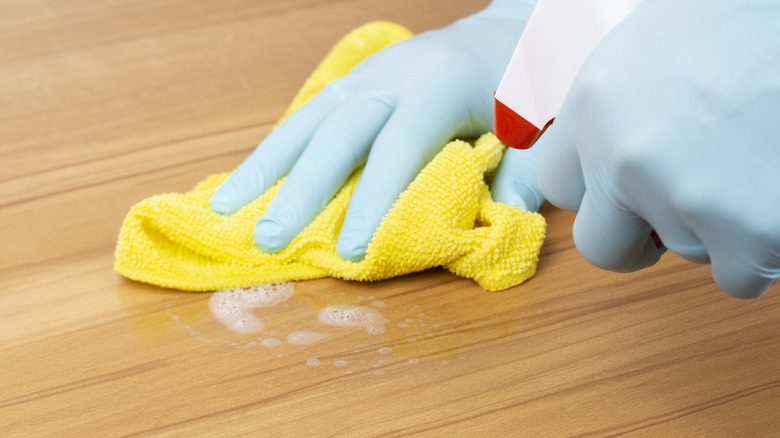Cleaning Laminate Flooring
Laminate flooring is easy to install, and it's even easier to keep clean. It comes with a baked-on factory finish that is harder than any finish you could apply yourself, and it takes more effort to damage it than it does to maintain it properly. That is not to say that your laminate flooring won't get damaged, though, because spills, scuffs and minor scratches happen all the time, so you need a strategy to handle them.
The factory finish is naturally shiny, so you never have to wax laminate flooring, and actually, you shouldn't. The best way to clean laminate floors is to vacuum frequently with a soft attachment and to mop occasionally with a microfiber mop and a laminate floor cleaner or a homemade cleaning solution of vinegar and water. Never wet mop, though, because water is your laminate floor's biggest enemy.
Don't Get Your Laminate Wet
Don't Get Your Laminate Wet
The visible part of a laminate plank is comprised of the pattern, which is printed on a thin, paper-like substrate, and the finish, which is there to protect it. Underneath, the bulk of each plank is formed by a high-density fiberboard core, which soaks up moisture and swells like a sponge.
If you spread water on the floor with a mop — or worse, use a steam mop — the water can seep through the gaps between planks. The cores of the planks swell and push against each other, causing warping, and the raised edges will ruin your floor's appearance. The only way to fix this problem is to replace the affected planks, so you want to stay away from wet mopping or using a steam mop, and you want to wipe up spills as soon as they occur.
A Strategy to Clean Laminate Floors
A Strategy to Clean Laminate Floors
Flooring dealers and cleaning professionals agree with Floor Critics, which recommends purchasing a microfiber mop to clean the laminate floors in your house. The best-known brand is Swiffer, but you don't have to limit yourself to a particular brand because many equivalent products are just as good. The advantage of a microfiber cloth or mop over a regular cotton mop or dust mop is that microfibers generate static electricity that attracts small dirt and dust particles.
Before you get out your mop, give the floor a good vacuuming to pick up small dirt particles that can lodge in the joints between boards and get ground into the finish by shoes. This is something you should do every week or two or even more often if the floor gets a lot of traffic. Make sure you use a vacuum cleaner attachment that won't scratch the finish, and don't use one with a rotary brush, which can also do damage.
After vacuuming, it's time for a damp mop or damp cloth. Spray a cleaning solution on the floor in front of the mop as you go to emulsify dirt so the mop can pick it up. This is preferable to dipping and wringing the mop, but you can do that, too, as long as you're judicious about wringing it. The mop should be damp but never wet.
Which Cleaning Solution Is Best?
Which Cleaning Solution Is Best?
You can buy any number of products specifically designed for cleaning laminate floors, most of which contain a solvent other than water, and dealers such as Shaw Floors recommend mopping with such products occasionally.
Laminate manufacturers such as Shaw and Armstrong offer proprietary cleaning products, and any one of them is suitable for all laminates, not just their own products. However, you can also get the job done with a 50/50 solution of vinegar and water, which is a time-honored cleaning solution for laminate and hardwood floors.
If you have to remove a stain, a laminate floor cleaner works better than vinegar and water. Because you often have to leave the cleaner on the stain to loosen it, a waterless cleaner is safer than a water solution. Rejuvenate, a popular cleaner for laminate, stone and tile floors, is a solution containing isopropylidene glycol instead of water, so it dries quickly and won't cause any warping.
Do not use oil soap, conventional floor polish or wax on your laminate floor. These products leave a film that eventually turns the finish dull, and they are unnecessary. If you want a cleaning product that restores shine while removing stains, squirt a drop or two of dish soap into a vinegar-water mixture and add a small amount of isopropyl alcohol to speed drying.
Getting Rid of Stains
Getting Rid of Stains
If you spill anything on your laminate flooring, it's important to wipe it up as soon as possible after the spill occurs so the liquid doesn't have a chance to seep into the cracks. Use a dabbing action to pick up liquids rather than a wiping motion, which will just push the liquid exactly where you don't want it to go.
Besides spills, you also have to deal with other types of stains. There's a technique and a cleaner for each one, but never try to rub off a stain or clean laminate floors with an abrasive material such as steel wool, which is guaranteed to ruin the finish.
- Allow large paint spills to dry and harden for a day or two before scraping off the paint with a plastic paint scraper. Large paint and wax spills are easier to remove after they have hardened. Wax generally hardens quickly, but if you're in a hurry, cover it with ice to harden it before scraping it.
- Remove ink and dye stains by rubbing with isopropyl alcohol, which is also great for removing residue after you've scraped off water-based paint. You can also remove these stains with nail polish remover that contains acetone, or you can use painter's acetone.
- Get out water spots and salt stains using the vinegar-water solution you mixed for general cleaning, but use hot water. For stubborn stains, make a paste with vinegar and borax, spread it on the affected area, cover it and leave it for a few hours before wiping it off.
Clean Laminate Floors With a Tennis Ball
Clean Laminate Floors With a Tennis Ball
The pros at Merry Maids share a trick that many cleaners use to remove scuff marks when cleaning laminate floors. They cut an "X" into a new tennis ball, insert a broom handle and use the ball as an eraser by rubbing it vigorously over the scuff marks. If you prefer, you can also use an actual rubber eraser, or you can use an old tennis shoe.
For really stubborn scuff marks, make a paste with baking soda and warm water and rub the paste into the marks with a microfiber cloth. Baking soda is just abrasive enough to get rid of the marks without doing any damage to the floor finish. In a pinch, you can also rub out scuff marks with acetone, although you need to rub more gently because acetone can affect the finish if you use it too aggressively.
